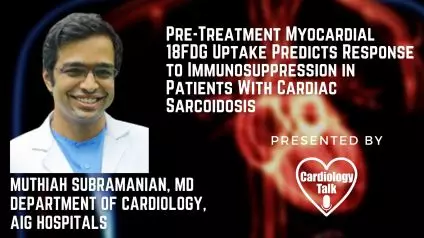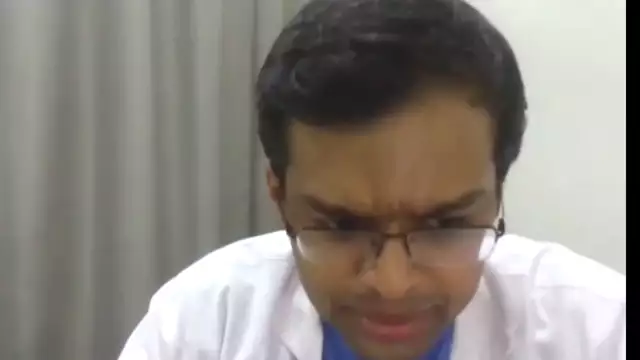Dr. Muthiah Subramanian MBBS, MD, DM, MRCP- @aig_electrophys #CardiacSarcoidosis #FDGPETUptake #Cardiology #Research
2 years
101 Views
Category:
Description:
Dr. Muthiah Subramanian is a Cardiologist and Eletrophysiologist at AIG Hospitals in Hyderabad, India. Dr. Subramanian has been practicing for over 10 years. In this video he will talk about the Pre-Treatment Myocardial 18FDG Uptake Predicts Response to Immunosuppression in Patients With Cardiac Sarcoidosis.
Link to Abstract- https://www.jacc.org/doi/abs/10.1016/j.jcmg.2020.11.016
Abstract
Objectives-
In patients with cardiac sarcoidosis, this study looked for determinants of clinical (CR) and echocardiographic (ER) responses after immunosuppressive therapy (IST) (CS).
Background-
For individuals with CS and active cardiac inflammation, IST has been the cornerstone of treatment. However, there is a scarcity of data to explain the IST's variable reaction in CS.
Methods-
The Granulomatous Myocarditis Registry provided data on 96 consecutive patients with CS. Before starting IST, all patients had an 18fluorodeoxy glucose positron emission tomography computed tomography (18FDG-PET-CT). After 4 to 6 months of therapy, the response was evaluated. A reduction in functional class (New York Heart Association functional class I) and the absence of ventricular arrhythmias and heart failure hospitalizations were used to define CR. An improvement of 10% or more in left ventricular ejection fraction (LVEF) was regarded as ER. Only patients with an LVEF of less than 50% were tested for ER. There was no residual myocardial FDG uptake in complete responders, and they met both response criteria. Only one of the response criteria was met by partial responders, or they exhibited residual FDG uptake. Non-responders failed to meet either the CR or the ER requirements. On 18FDG-PET-CT, the uptake index (UI) was calculated by multiplying the maximal standardized uptake value by the number of LV segments with aberrant uptake.
Results-
54.9 percent, 20.9 percent, and 24.2 percent of the 91 patients included in the final analysis were classified as complete, partial, and non-responders, respectively. LVEF >40% (hazard ratio: 1.61; 95 percent confidence interval: 1.06 to 7.69; p = 0.031) and myocardial UI >30 (hazard ratio: 1.28; 95 percent confidence interval: 1.05 to 6.12; p = 0.010) were identified as independent predictors of response following immunosuppression in a Cox regression analysis (all responders vs. non-responders). The resultant model exhibited a high level of discriminative power (AUC: 0.85) and prediction accuracy (sensitivity: 85.5 percent ; specificity: 86.4 percent ). The change in LVEF after immunosuppression was strongly correlated with pre-treatment myocardial UI.
Conclusions-
Pre-treatment In individuals with CS, 18FDG myocardial uptake was a predictor of CR and ER responses to immunosuppression.
Link to Abstract- https://www.jacc.org/doi/abs/10.1016/j.jcmg.2020.11.016
Abstract
Objectives-
In patients with cardiac sarcoidosis, this study looked for determinants of clinical (CR) and echocardiographic (ER) responses after immunosuppressive therapy (IST) (CS).
Background-
For individuals with CS and active cardiac inflammation, IST has been the cornerstone of treatment. However, there is a scarcity of data to explain the IST's variable reaction in CS.
Methods-
The Granulomatous Myocarditis Registry provided data on 96 consecutive patients with CS. Before starting IST, all patients had an 18fluorodeoxy glucose positron emission tomography computed tomography (18FDG-PET-CT). After 4 to 6 months of therapy, the response was evaluated. A reduction in functional class (New York Heart Association functional class I) and the absence of ventricular arrhythmias and heart failure hospitalizations were used to define CR. An improvement of 10% or more in left ventricular ejection fraction (LVEF) was regarded as ER. Only patients with an LVEF of less than 50% were tested for ER. There was no residual myocardial FDG uptake in complete responders, and they met both response criteria. Only one of the response criteria was met by partial responders, or they exhibited residual FDG uptake. Non-responders failed to meet either the CR or the ER requirements. On 18FDG-PET-CT, the uptake index (UI) was calculated by multiplying the maximal standardized uptake value by the number of LV segments with aberrant uptake.
Results-
54.9 percent, 20.9 percent, and 24.2 percent of the 91 patients included in the final analysis were classified as complete, partial, and non-responders, respectively. LVEF >40% (hazard ratio: 1.61; 95 percent confidence interval: 1.06 to 7.69; p = 0.031) and myocardial UI >30 (hazard ratio: 1.28; 95 percent confidence interval: 1.05 to 6.12; p = 0.010) were identified as independent predictors of response following immunosuppression in a Cox regression analysis (all responders vs. non-responders). The resultant model exhibited a high level of discriminative power (AUC: 0.85) and prediction accuracy (sensitivity: 85.5 percent ; specificity: 86.4 percent ). The change in LVEF after immunosuppression was strongly correlated with pre-treatment myocardial UI.
Conclusions-
Pre-treatment In individuals with CS, 18FDG myocardial uptake was a predictor of CR and ER responses to immunosuppression.



